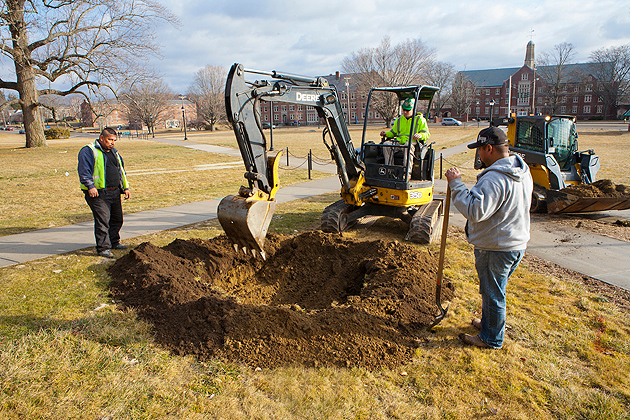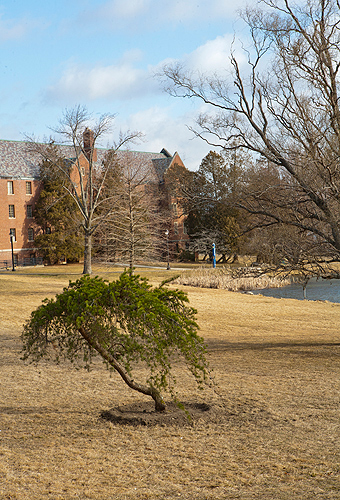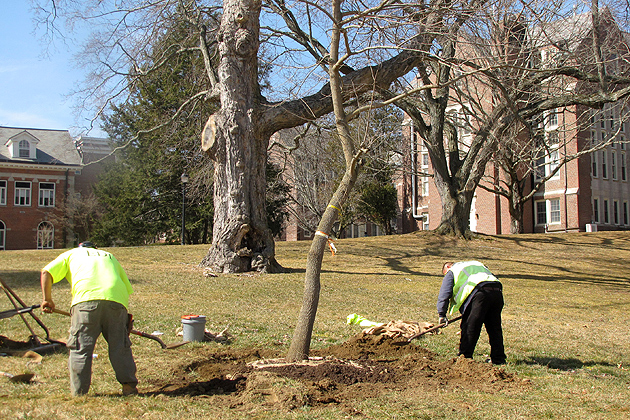
UConn’s commitment to beautifying its campuses and being environmentally friendly has taken another step forward with the addition of six more trees to the already extensive arboretum on the Storrs campus.
The new additions are the Hornbeam Maple (Acer carpinifolium), Henry’s Maple (Acer henryi), Common Pawpaw (Asiminia triloba), Common Persimmon (Diospyros virginiana), Varied Directions European Larch (Larix decidua ‘Varied Directions’ ), and the Uncle Fogy Jack Pine (Pinus banksiana ‘Uncle Fogy’).
Mark Brand, professor of plant science and landscape architecture in the College of Agriculture and Natural Resources, and co-chairman of the University’s Arboretum Committee, says the six additions are part of ongoing efforts to showcase interesting and diverse specimens.

“The trees have been transplanted from the University’s Burr Teaching Nursery at the Plant Science Teaching and Research Farm and the Waxman conifer collection [named after long-time professor of plant science Sidney Waxman],” Brand says, “and each is an important addition with a story of its own.”
Two of the trees, the Persimmon and the Pawpaw, are native to Connecticut and are becoming part of the University’s developing collection of edible landscape plants. Although the fruit of the persimmon can be quite sour, that of the pawpaw is not only delicious, but is also rich in vitamins A and C and has important antioxidant properties.
According to Greg Tormey, horticulturist in the department of plant science and landscape architecture, “The fruit tastes something like banana custard, and the main reason it is not more widely known is that it spoils quickly once harvested and is intolerant of shipping and handling. That’s why you don’t see them as much in larger grocery store chains.”
While travel may be problematic, the fruit of the pawpaw can be found in area farmer’s markets throughout the summer and Tormey says it makes a promising addition to menus featuring locally grown produce.

The transplanted trees vary in size from 8 to 30 feet high and are an outgrowth of research projects carried on by several generations of plant science students. The history of each tree includes details of origin – some were received as seedlings from the United States Department of Agriculture (USDA), and some were propagated on campus – and the various traits that make them such valued additions to the collection.
“We get about five or six plants a year that the USDA wants us to try growing,” says Tormey. “We have a great micro-climate here [in Storrs], with good air drainage, so we’re able to grow trees that might not thrive elsewhere, even in other areas of the state.”
One of the trees that does do well in Connecticut is the Hornbeam Maple, and the tree that has been transplanted originally came to UConn from the USDA in 1992 as a seedling. It’s an interesting specimen because its oblong, striated leaves don’t resemble those of other maple trees. The species is native to Asia, where it is often used as an ornamental plant due to its relatively small size.
Another new addition is home grown, and comes from the Waxman collection. Varied Directions is a deciduous conifer that was developed by Waxman as part of his research here at UConn. It’s a cultivar – propagated via stem cuttings – that forms a weeping, spreading plant with branches that radiate in irregular patterns. “I love this particular tree,” Tormey says, “because not only is it home grown, it has a really interesting shape and it can look like a giraffe or elephant even without pruning. It’s really a great plant that owes its existence to Sid Waxman.”
UConn’s extensive collection of trees and ornamental shrubs serves to beautify the campus while also providing a living laboratory for students enrolled in plant science, biology, environmental science, and other related courses. A walking tour highlighting 40 of the University’s most interesting specimens has been prepared by the Arboretum Committee. In addition, more than 2,000 trees on campus have been tagged with small metal discs and entered into a Geographic Information System which shows their exact location and other pertinent information.
Locations for the six newly transplanted trees are:
Varied Directions European Larch – the slope outside the Tasker Building
Uncle Fogy Jack Pine – beside Mirror Lake
Common Persimmon – Great Lawn
Common Pawpaw – Great Lawn
Henry’s Maple – Waxman Display Garden, outside the Young Building
Hornbeam Maple – Hillside Road



